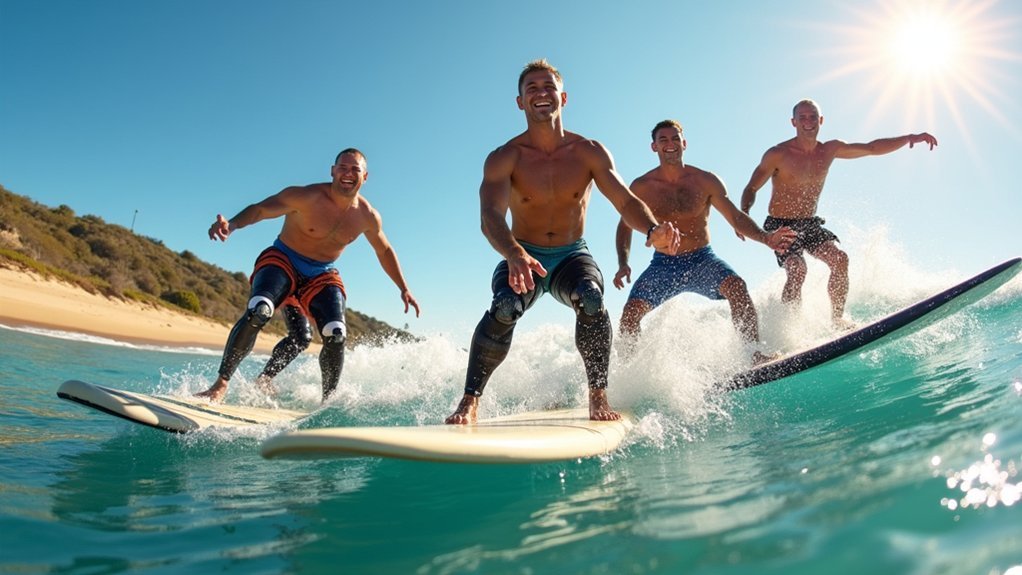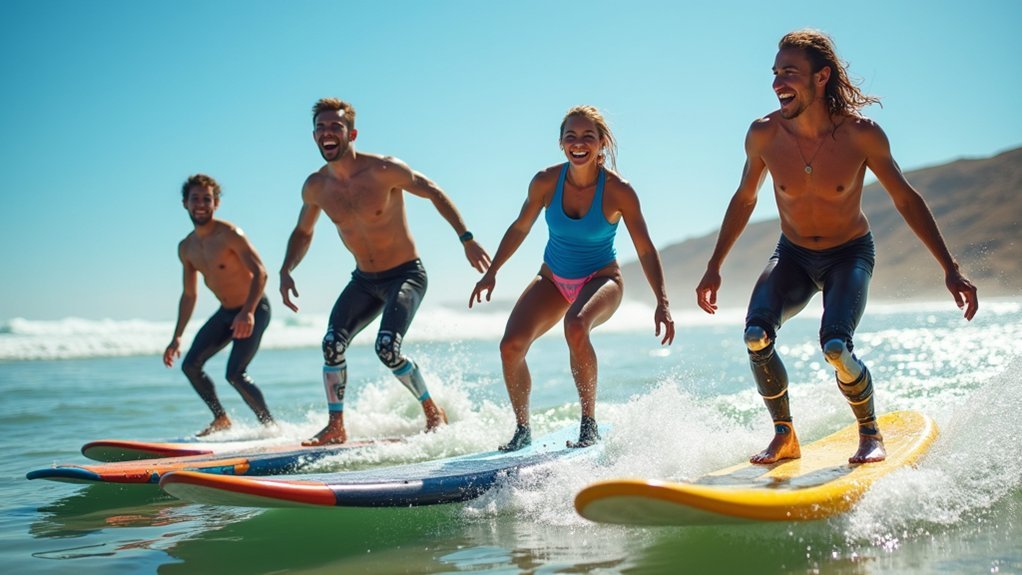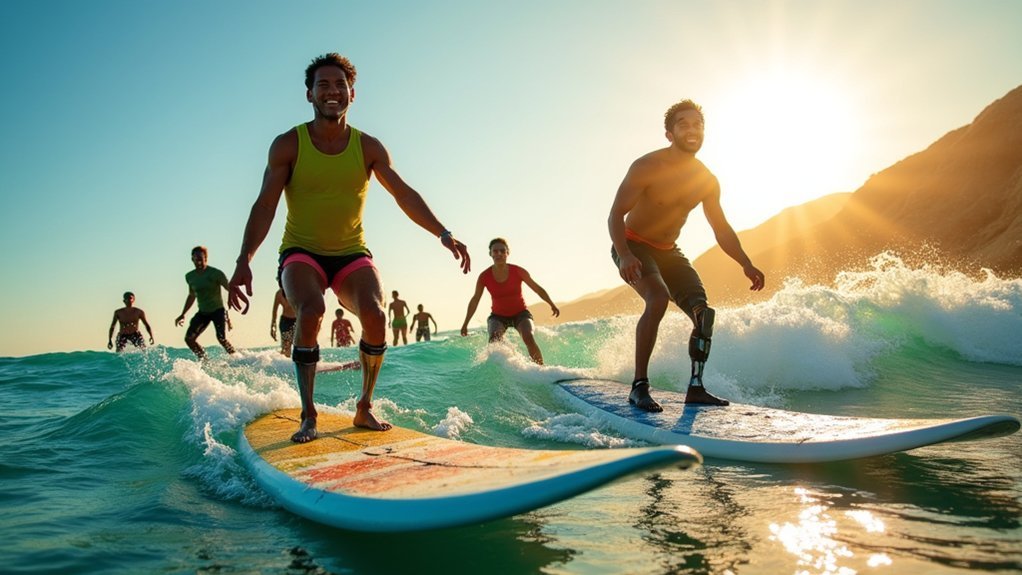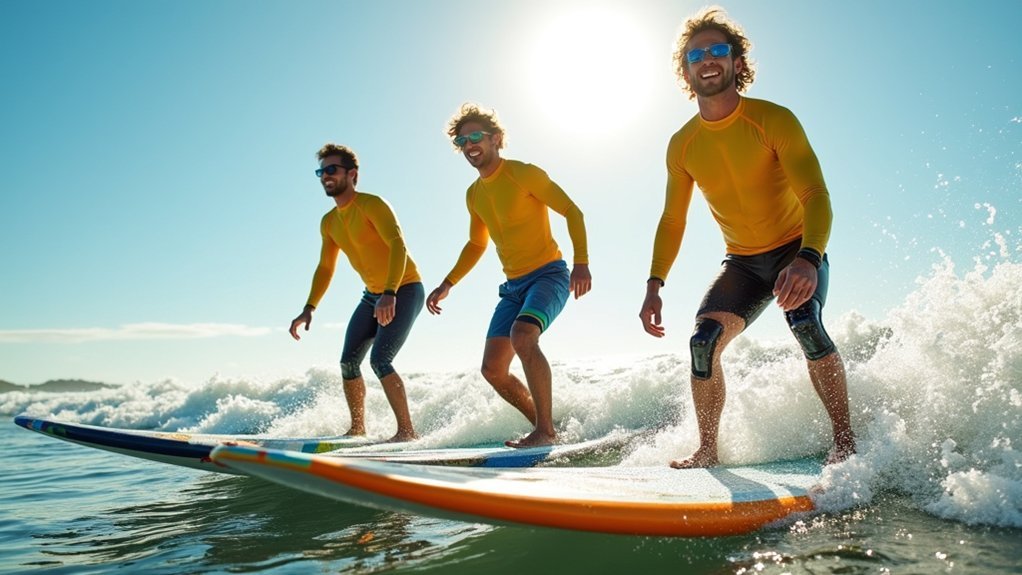Amputees enjoy the thrill of surfing through specialized equipment and adaptations. Custom surfboards feature reinforced decks, security straps, and balanced weight distribution tailored to your specific needs. Waterproof prosthetics like the Swell Surf Foot ($500-$600) offer flexibility and saltwater resistance. Many veterans find surf therapy reduces PTSD and depression symptoms while building supportive communities. Organizations like Warrior Surf Foundation provide coaching and monthly clinics to help you master the waves and transform your life.
The Transformative Power of Surf Therapy for Veterans

While the mental health crisis among veterans continues to reach alarming rates, surf therapy has emerged as a powerful alternative treatment for those suffering from PTSD, anxiety, and depression.
With veteran suicide rates at approximately 22 deaths per day and only 40% of those with PTSD seeking help, organizations like Warrior Surf Foundation offer essential support.
You’ll find immediate relief from symptoms when catching waves, as surf therapy promotes mindfulness by keeping you focused on the present moment.
The combination of physical activity and natural ocean environment creates a “flow state” that reduces stress while building a sense of accomplishment.
Research shows significant decreases in PTSD and depression symptoms among participants.
Beyond surfing, these programs incorporate yoga, wellness coaching, and community building—encouraging graduates to support fellow veterans in their healing journey.
Engineering Innovation: How Surfboards Are Adapted for Amputees
For many veterans finding peace in the waves, participation would remain impossible without remarkable engineering breakthroughs that have revolutionized adaptive surfing.
You’ll notice these specialized boards feature customized handgrips, security straps, and specialized seating to accommodate different disabilities.
They’re constructed with more durable foam and fiberglass than standard boards, providing the extra stability and support you need when facing mobility challenges.
The innovation extends beyond the boards themselves.
Prosthetics like the Swell Surf Foot utilize a dual urethane bushing system, offering unprecedented ankle flexibility and grip while resisting saltwater corrosion.
Priced around $500-$600, these waterproof prosthetics can be adjusted right at the beach, optimizing your performance as conditions change.
These engineering advances don’t just enable participation—they transform the entire surfing experience.
Personalized Prosthetics: Meeting the Challenges of Ocean Sports

When surfers with limb differences paddle out to face ocean swells, they need more than standard prosthetics—they require gear engineered specifically for marine environments.
You’ll find prosthetists working closely with surfers to create customized solutions that balance waterproofing, flexibility, and stability.
Today’s ocean sport prosthetics incorporate:
- Waterproof components that withstand saltwater corrosion while maintaining functionality
- Carbon fiber and titanium materials offering lightweight durability under high-impact conditions
- Microprocessor technology mimicking natural joint movements for better wave navigation
- Custom-fitted sockets designed for comfort during paddling and standing maneuvers
- Specialized feet with enhanced energy return systems for improved board control
These adaptations don’t just enable participation—they optimize performance, allowing you to carve waves with confidence whether you’re a beginner or competitive athlete.
From Battlefield to Breakers: Success Stories of Amputee Surfers
Veterans returning from combat zones have carved a remarkable path in adaptive surfing, transforming personal tragedy into triumph on the waves. Like Bethany Hamilton and Dani Burt, these warriors demonstrate extraordinary resilience despite significant physical challenges.
You’ll find many veterans adopting modified techniques—squatting postures and intense balance management—to stay stable on their boards. They’ve pioneered DIY solutions, creating homemade prosthetics when conventional options fail in ocean environments.
What’s most striking is how these surfers overcome both physical and psychological barriers. Through regular training and participation in adaptive surfing championships, they’ve built communities that support newcomers facing economic constraints and accessibility issues.
Adaptive surfers build more than skills—they create pathways to freedom that transcend all barriers.
Their stories don’t just inspire—they’re driving innovation in waterproof prosthetics and specialized equipment that makes the ocean accessible to all.
Building Community Through Adaptive Surf Programs

Adaptive surf programs worldwide have transformed the landscape of inclusivity in ocean sports, creating vibrant communities where amputees and people with various disabilities thrive together.
You’ll find these programs offer more than just surfing lessons—they provide belonging, empowerment, and lifelong connections.
When you join an adaptive surf community, you’ll experience:
- Monthly clinics where you can learn techniques while building friendships with fellow adaptive surfers
- Dedicated volunteer support both in and out of the water, ensuring your safety and success
- Team-building activities that strengthen community bonds while giving back
- Access to qualified adaptive surf coaches who understand your specific needs
- Financial assistance through donations that fund specialized equipment and program costs
These supportive ecosystems challenge traditional disability perceptions while providing physical rehabilitation and mental well-being benefits.
The Evolution of Custom Board Design for Different Amputation Types
The heart of any adaptive surfing experience lies in the custom board itself—a marvel of engineering that’s continuously evolved to address the unique needs of amputee surfers. Different amputation types require specific adaptations to guarantee both control and stability in the water.
| Amputation Type | Board Modification | Materials Used |
|---|---|---|
| Lower Limb | Reinforced deck, balanced weight distribution | Carbon fiber, extra fiberglass |
| Upper Limb | Custom handles, modified grip points | High-density foam, textured surfaces |
| Multiple Limb | Integrated support systems, specialized balance features | Hybrid materials, adaptive handles |
You’ll find boards now featuring adaptive materials that withstand prosthetic pressure points while maintaining performance. These custom designs incorporate everything from specialized grip options to built-in handles that help you maneuver through waves with confidence, regardless of your amputation type.
Frequently Asked Questions
What Are the Costs Associated With Adaptive Surfboard Customization?
You’ll find customizable grips ranging from £41.63 to £79.17, while additional features like foam wedges, straps, and high-tech adaptations can greatly increase costs. Community organizations may offer financial assistance for equipment.
How Long Does It Take to Learn Surfing With Prosthetics?
Learning to surf with prosthetics typically takes 3-6 months. You’ll adapt faster with prior surfing experience, proper prosthetic fitting, and qualified instruction. Everyone’s journey differs based on your fitness level and determination.
Are There Surfing Competitions Specifically for Amputee Surfers?
Yes, you’ll find specific competitions for amputee surfers in events like the Adaptive Surfing Professionals World Championship Tour, which uses classification systems to guarantee fair competition across different amputation types and levels.
What Safety Precautions Should Amputee Surfers Take?
As an amputee surfer, you’ll need waterproof prosthetics, protective covers to prevent friction, double leashes for security, and proper skin care. Always assess sea conditions and establish emergency protocols before hitting the waves.
Can Adaptive Surfboards Be Rented Rather Than Purchased?
Yes, you can rent adaptive surfboards through organizations like The Adaptive Surf Project. They’re available during events or training sessions. Rentals save money, let you try different designs, and often include expert guidance.
In Summary
When you’re riding the waves as an amputee, you’re not just surfing—you’re redefining what’s possible. You’ve seen how custom boards and adaptive equipment transform limitations into opportunities. Whether you’re a veteran finding healing or someone who’s always dreamed of surfing, today’s innovations guarantee the ocean welcomes everyone. Your community’s growing, and the future of adaptive surfing looks brighter than ever. Keep paddling out.





Leave a Reply